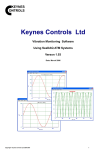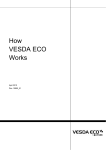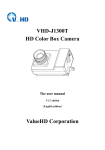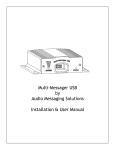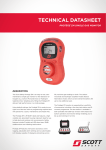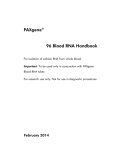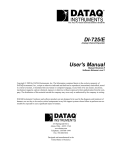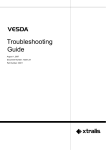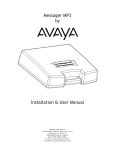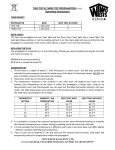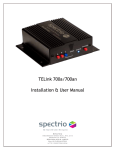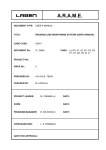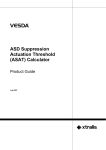Download VESDA ECO Test Gas Guide
Transcript
VESDA ECO
Test Gas
Guide
May, 2012
Doc. 19517_03
VESDA ECO Test Gas Guide
Disclaimer
The contents of this document is provided on an "as is" basis. No representation or warranty (either express or implied)
is made as to the completeness, accuracy or reliability of the contents of this document. The manufacturer reserves the
right to change designs or specifications without obligation and without further notice. Except as otherwise provided, all
warranties, express or implied, including without limitation any implied warranties of merchantability and fitness for a
particular purpose are expressly excluded.
Intellectual Property and Copyright
This document includes registered and unregistered trademarks. All trademarks displayed are the trademarks of their
respective owners. Your use of this document does not constitute or create a licence or any other right to use the name
and/or trademark and/or label. This document is subject to copyright owned by Xtralis AG ("Xtralis"). You agree not to
copy, communicate to the public, adapt, distribute, transfer, sell, modify or publish any contents of this document without
the express prior written consent of Xtralis.
General Warning
This product must only be installed, configured and used strictly in accordance with the General Terms and Conditions,
User Manual and product documents available from Xtralis. All proper health and safety precautions must be taken
during the installation, commissioning and maintenance of the product. The system should not be connected to a power
source until all the components have been installed. Proper safety precautions must be taken during tests and
maintenance of the products when these are still connected to the power source. Failure to do so or tampering with the
electronics inside the products can result in an electric shock causing injury or death and may cause equipment
damage. Xtralis is not responsible and cannot be held accountable for any liability that may arise due to improper use of
the equipment and/or failure to take proper precautions. Only persons trained through an Xtralis accredited training
course can install, test and maintain the system.
Liability
You agree to install, configure and use the products strictly in accordance with the User Manual and product documents
available from Xtralis.
Xtralis is not liable to you or any other person for incidental, indirect, or consequential loss, expense or damages of any
kind including without limitation, loss of business, loss of profits or loss of data arising out of your use of the products.
Without limiting this general disclaimer the following specific warnings and disclaimers also apply:
Fitness for Purpose
You agree that you have been provided with a reasonable opportunity to appraise the products and have made your
own independent assessment of the fitness or suitability of the products for your purpose. You acknowledge that you
have not relied on any oral or written information, representation or advice given by or on behalf of Xtralis or its
representatives.
Total Liability
To the fullest extent permitted by law that any limitation or exclusion cannot apply, the total liability of Xtralis in relation
to the products is limited to:
(i) in the case of services, the cost of having the services supplied again; or
(ii) in the case of goods, the lowest cost of replacing the goods, acquiring equivalent goods or having the goods
repaired.
Indemnification
You agree to fully indemnify and hold Xtralis harmless for any claim, cost, demand or damage (including legal costs on
a full indemnity basis) incurred or which may be incurred arising from your use of the products.
Miscellaneous
If any provision outlined above is found to be invalid or unenforceable by a court of law, such invalidity or
unenforceability will not affect the remainder which will continue in full force and effect. All rights not expressly granted
are reserved.
Document Conventions
The following typographic conventions are used in this document.
Convention
Doc. 19517_03
Description
Bold
Used to denote: emphasis
Used for names of menus, menu options, toolbar buttons
Italics
Used to denote: references to other parts of this document or other documents. Used for the
result of an action
i
VESDA ECO Test Gas Guide
The following icons conventions are used in this document.
Convention
Description
Caution: This icon is used to indicate that there is a danger to equipment. The danger could be
loss of data, physical damage, or permanent corruption of configuration details.
Warning: This icon is used to indicate that there is a danger of electric shock. This may lead to
death or permanent injury.
Warning: This icon is used to indicate that there is a danger of inhaling dangerous substances.
This may lead to death or permanent injury.
Contact Us
The Americas +1 781 740 2223 Asia +852 2916 8876 China +8621 5240 0077
Australia and New Zealand +61 3 9936 7000 Middle East +962 6 588 5622 UK +44 1442 242 330
www.xtralis.com
ii
Doc. 19517_03
VESDA ECO Test Gas Guide
Contents
Warning .............................................................................................................................................1
Scope.................................................................................................................................................1
Overview............................................................................................................................................1
Sensor life .........................................................................................................................................2
Routine testing/calibration ..................................................................................................... 3
Zero calibration .......................................................................................................................4
Span calibration ...................................................................................................................... 4
Oxygen detectors .................................................................................................................... 4
Calibration procedure ............................................................................................................. 4
Toxic gas detectors.................................................................................................................4
Flammable gas detectors........................................................................................................4
Test/calibration/test gas cylinders .........................................................................................4
Calibration / test gas suppliers...............................................................................................5
Doc. 19517_03
VESDA ECO Test Gas Guide
Warning
Before using any test / calibration gas; reference should be made to supplier Material Safety Data
Sheets (MSDS) for all safety recommendations.
Always ensure there is sufficient ventilation to prevent ingestion of potentially harmful levels of test gas
or the build-up of potentially hazardous concentrations.
Ensure that ceiling spaces and voids are adequately ventilated when using gases that are lighter than
air.
Ensure low lying areas (inspection pits, floor voids, basements etc.) are adequately ventilated when
using gases that are heavier than air.
ALWAYS ADHERE TO LOCAL HEALTH AND SAFETY REGULATIONS WHEN HANDLING
HAZARDOUS GASES.
Scope
This document provides an overview of suitable test/calibration equipment required to conduct routine
response checks or calibration of VESDA ECO gas detectors along with contact details of potential
test gas suppliers.
Overview
VESDA ECO adds gas detection capability to existing or new installations of VESDA
Aspirating Smoke Detection (ASD) systems that typically utilize 25mm or ¾” BSP airsampling pipe networks.
The VESDA ECO can detect a range of flammable gases, toxic gases and oxygen
deficiency.
Each VESDA ECO detector houses a replaceable sensor cartridge which can contain
one or two gas sensors.
VESDA ECO uses the same well proven core sensing technologies that have been
successfully used by the gas detection industry for many years. (see Table 1)
VESDA ECO currently employs three core sensing principles: Catalytic bead (often
referred to as Pellistors) for the detection of flammable gases. Electrochemical cells for
the detection of toxic gases and for oxygen deficiency. Infrared for the detection of
carbon dioxide.
The majority of gas sensors have a finite life (see Table 1). Sensor life is
dependant on the type of sensing principle, any internal chemistry and
the environmental conditions it is exposed to.
This makes it difficult to precisely predict the end of life for any gas
sensor. With the exception of the oxygen deficiency detector and the infra
red detecting principle used for carbon dioxide; these sensing
technologies are not failsafe. That is to say; they do not provide any
indication when the operating life has expired.
Routine (typically 6 monthly) exposure to test/calibration gas is
recommended for all gas types to verify gas sensor response and revalidate the accuracy of gas concentration readings.
The test/calibration process requires the use of a zero gas and a span gas. Zero gas (e.g. clean air for
flammable gas detectors, Nitrogen for toxic gas and Oxygen deficiency detectors), plus span gas e.g.
a known concentration; (typically 50% of full scale); of the target gas to be detected.
Doc. 19517_03
1
VESDA ECO Test Gas Guide
Sensor life
The life of a toxic gas electrochemical cell is related to the working life of its internal chemistry and is
typically 24 months.
Oxygen fuel cells consume their internal chemistry during normal operation, their life can be measured
in ppm hours based on an ambient of 20.9 % v/v and have a typical life in excess of 18 months.
Ammonia cells have a life of 18-24 months, this assumes they are operating in an environment free of
any background concentration of Ammonia.
The life of flammable gas sensors that use catalytic beads can be many years; typically greater than
three years. Their life is directly related to the amount of catalytic poisons they are exposed to.
Catalytic poisons include silicon or sulphur based compounds e.g. silicon based: furniture polish,
electrical contact releasing sprays and lubricants, like WD40.
VESDA ECO uses catalytic beads with integral filters to ensure the longest possible operating life.
Infrared sensing elements should also operate for several years, typically greater than five and
possibly ten.
Chemical
Formula
Detection
Range
Detection principle
Typical sensor
life
Ammonia
NH3
0-100 ppm
Electrochemical cell
18 to 24 months *
Carbon Monoxide
CO
0-500 ppm
Electrochemical cell
18 to 24 months
Chlorine
Cl2
0-20 ppm
Electrochemical cell
18 to 24 months
Hydrogen
H2
0-2000 ppm
Electrochemical cell
18 to 24 months
Hydrogen Sulphide
H2S
0-100 ppm
Electrochemical cell
18 to 24 months
Nitrogen Dioxide
NO2
0-10 ppm
Electrochemical cell
18 to 24 months
O2
0-25% v/v
Electrochemical fuel cell
18 to 24 months
Gas name
Oxygen
Sulphur Dioxide
SO2
0-10 ppm
Electrochemical cell
18 to 24 months
Alcohols
NA
0-100% LFL
Catalytic bead / Pellistor
3 to 5 years
Ammonia
NH3
0-100% LFL
Catalytic bead / Pellistor
3 to 5 years
Gasoline Vapours
NA
0-100% LFL
Catalytic bead / Pellistor
3 to 5 years
Hydrogen
H2
0-100% LFL
Catalytic bead / Pellistor
3 to 5 years
Methane
CH4
0-100% LFL
Catalytic bead / Pellistor
3 to 5 years
Pentane
C5H12
0-100% LFL
Catalytic bead / Pellistor
3 to 5 years
Propane
C3H8
0-100% LFL
Catalytic bead / Pellistor
3 to 5 years
Carbon Dioxide
CO2
0-5% v/v
Infrared
> 5 years
Table 1: Gas type – sensing technology – typical sensor life
Note: Those marked with an * assumes operation in atmospheres free of any background concentration of the target gas.
2
Doc. 19517_03
VESDA ECO Test Gas Guide
Routine testing/calibration
To perform routine testing and calibration of VESDA ECO gas detectors you will need the following:
A Microsoft Windows enabled laptop or PC
Xtralis VSC configuration software. (Free download from the Xtralis partner website after
registration)
Cylinder of zero gas (clean air or Nitrogen)
Cylinder of span / calibration gas (see Table 2)
Flow regulator capable of delivering a flow rate of 0.5 litres / minute (1.0 l/m for Cl2) using
6mm (¼”) outside diameter; 4mm (~1/8”) inside diameter pipe for connecting the gas to the ECO
calibration port
Product manual calibration procedure.
Examples of calibration kit and flow regulator.
Will vary based on supplier.
The recommended test gas concentrations for each sensor type/measurement range are given in
Table 2.
Chemical
formula
Measurement
Range
Ammonia
NH3
Carbon
Monoxide
Gas Name
Factory Default Setting
Temperature
Limit
Humidity Limit
Recommended
Test Gas
Concentration
Pre
Alarm
Alarm
Low
High
Low
High
0-100 ppm
6 ppm
9 ppm
-20°C
+40°C
15 %RH
90 %RH
50 ppm
CO
0-500 ppm
7 ppm
50 ppm
-20°C
+50°C
15 %RH
90 %RH
100 ppm
Carbon
Dioxide
CO2
0-5% v/v
0.5% v/v
1.5% v/v
-10°C
+50°C
10 %RH
90 %RH
2.0% v/v
Chlorine
Cl2
0-20 ppm
0.1 ppm
0.3 ppm
-20°C
+40°C
10 %RH
90 %RH
5 ppm*
(See note)
Hydrogen
H2
0-2000 ppm
500 ppm
1000 ppm
-20°C
+50°C
15 %RH
90 %RH
1000 ppm
Hydrogen
Sulphide
H2 S
0-100 ppm
1 ppm
2 ppm
-20°C
+50°C
15 %RH
90 %RH
20 ppm
Nitrogen
Dioxide
NO2
0-10 ppm
0.3 ppm
0.5 ppm
-20°C
+50°C
15 %RH
90 %RH
5 ppm
Oxygen
Deficiency
O2
0-25% v/v
20 % v/v
19.5% v/v
-20°C
+55°C
5 %RH
95 %RH
20.9% v/v
Oxygen
Deficiency &
Enrichment
O2
0-25% v/v
19.5% v/v
22.5% v/v
-20 C
+55°C
5 %RH
95 %RH
20.9% v/v
Sulphur
Dioxide
SO2
0-10 ppm
0.3 ppm
0.5 ppm
-20°C
+50°C
15 %RH
90 %RH
5 ppm
Alcohols
(IPA)
__
0-100% LFL
7 %LFL
12 %LFL
-20°C
+50°C
5 %RH
90 %RH
42 %LFL in Air†
Ammonia
NH3
0-100% LFL
7 %LFL
12 %LFL
-20°C
+50°C
5 %RH
90 %RH
36 %LFL in Air††
Gasoline
__
0-100% LFL
7 %LFL
12 %LFL
-20°C
+50°C
5 %RH
90 %RH
46 %LFL in Air†
Hydrogen
H2
0-100% LFL
7 %LFL
12 %LFL
-20°C
+50°C
5 %RH
90 %RH
50 %LFL in Air
CH4
0-100% LFL
7 %LFL
12 %LFL
-20°C
+50°C
5 %RH
90 %RH
50 %LFL in Air
Propane
C3 H8
0-100% LFL
7 %LFL
12 %LFL
-20°C
+50°C
5 %RH
90 %RH
42 %LFL in Air†
Pentane
C5H12
0-100% LFL
7 %LFL
12 %LFL
-20°C
+50°C
5 %RH
90 %RH
50 %LFL in Air
Methane /
Natural Gas
Table 2: Gas Types, Measurement ranges and recommended test gas concentrations
Notes: (*) requires a gas flow at 1 litre per minute
(†) Cross-calibrated using 50% LFL Pentane (C5H12) in Air
(††) Cross-calibrated using 50% LFL Methane (CH4) in Air
Doc. 19517_03
3
VESDA ECO Test Gas Guide
Zero calibration
Zero calibration of flammable gas sensors requires the use of clean air, e.g. ambient air without the
presence of combustible gases, this can be referred to as "zero gas". Zero calibration of toxic gas
sensors can be performed using zero gas or 100% v/v Nitrogen which is also referred to as "zero gas".
Zero calibration of Oxygen and Carbon Dioxide sensors also requires the use of an inert gas such as
100% v/v Nitrogen.
Span calibration
Span calibration is the setting of a detector to read the same concentration as supplied in a
test/calibration gas cylinder.
Span gas concentrations are typically 50% of scale, but can be any concentration between 10% and
90% of scale.
Oxygen detectors
Span calibration of Oxygen detectors can be performed using ambient air provided it can be confirmed
that no interference gases are present.
Calibration procedure
Refer to the VESDA ECO product guide for full details of the calibration procedure.
Toxic gas detectors
When calibrating toxic gas detectors, gas cylinders containing a known concentration of the target gas
(typically 50% of the measuring range) should be used.
Flammable gas detectors
When calibrating flammable gas detectors, gas cylinders containing a known concentration of the
target gas (typically 50% of the measuring range) should be used. However some flammable gases
are either not available or unsuitable for storage in pressurised containers.
Under these circumstances it is possible to calibrate for the target flammable gas using an alternative
flammable gas with the use of a correction factor See table two for more information.
Test/calibration/test gas cylinders
Test / calibration gas cylinders are available in most countries. To ensure ease of handling and reduce
costs Xtralis recommend the use of small disposable aluminium alloy or steel cylinders with a gas
capacity ranging from 34 to around 110 litres.
A flow regulator will be required to deliver a flow rate of up to 0.5 litres a minute. It should be possible
to calibrate in excess of 12 sensors from a 34 litre cylinder and 40 sensors from a 110 litre cylinder at
a flow rate of 0.5 litres / minute.
Cylinders regulations vary between countries and regions, check which regulations apply to your
country before ordering. Alternatively the recommended suppliers listed below will be able to help.
American gas cylinders comply with US Dot standards
European gas cylinders comply with : EN12205
Note: Smaller 12 / 20 litre; aerosol type; canisters are not recommended due to their small capacity
and the inability to accurately regulate the flow.
To ensure the accuracy of the calibration gas mixture, suppliers quote a shelf life for the cylinders
contents. At the end of this life the accuracy of the contents can not be guaranteed. The typical shelf
life for flammable calibration gas is 36 months and 12 months for most toxic mixes. Check with your
suppler for exact details.
4
Doc. 19517_03
VESDA ECO Test Gas Guide
Calibration / test gas suppliers
If you are unable to source calibration test kits in your country, Xtralis has partnered with 3 regional
suppliers, see contact details and product part numbers below.
Each of these suppliers can supply test gases globally, most have regional distributors which can often
supply these gases at a reduced price due to their ability to consolidate consignments and ordering in
bulk.
Contact any of these suppliers direct to learn of your nearest distributor.
Costs may vary between suppliers. We recommend alternative quotes are obtained covering price and
delivery times.
The following table of supplier part numbers is supplied for reference purposes only. Check supplier
part numbers and descriptions with any potential supplier before ordering or when cylinders of different
gas mixtures are required.
Region
Supplier
Europe & Middle East
Air Products PLC
(Formerly Cryoservices)
Warndon Business Park,
Worcester,
WR4 9RH,
UK
Tel +44(0)1905 758 200
Fax: +44(0)1905 457824
Email:
[email protected]
www.airproducts.com
Gases and concentrations
Cylinder capacity - gas litres
Ammonia (50 ppm) in Nitrogen (see note
1)
Americas
Gasco
320 Scarlet Boulevard,
Oldsmar,
Florida 34677
USA
Toll free: 800-910-0051
Local: 813-343-5631
Fax: 866-755-8920
Email:
[email protected]
www.gascogas.com
Australasia & Asia Pacific
CAC Gas & Instrumentation
Unit 10, Junction Estate
2 Duck Street,
Auburn,
NSW
Australia 2144
Tel: +61 (0)2 9735 8833
Fax: +61 (0)2 9735 8899
Email:
[email protected]
www.cacgas.com.au
110 Litre Disposable
Aluminium alloy
cylinders
Part Numbers
103 Litre Disposable
Steel cylinders
Part Numbers
34,103 or 112 Litre
Disposable Cylinders
DA: Disposable
Aluminium
DS: Disposable Steel
Part Numbers
312680
103L-13-50
34DA50NH3N
Carbon Dioxide 2.0% in Nitrogen
312701
103L-35-2
103DS2CO2N
Carbon Monoxide (100 ppm) in Nitrogen
312043
103L-49-100
103DS100CON
Chlorine 5 ppm in Nitrogen (see note 1)
312937
116L-252-5
(116 L Aluminium alloy)
34DA5CL2N
Hydrogen (1000 ppm) in air
312153
103L-92-1000
103DS1000H2A
Hydrogen Sulphide (20ppm) in Nitrogen
(see note 1)
312158
103L-98-20
112DA20H2SN
Nitrogen (100%)
197140
103L-114
103DSN
TBA
103L-111-5
34DA5NO2N
Nitrogen Dioxide (5 ppm) in Nitrogen
(see note 1)
Oxygen (18%) in nitrogen
TBA
Not applicable
103DS18O2N
Oxygen (20.9%) in Nitrogen
312016
103L-1
103DS20.902N
Sulphur Dioxide (5 ppm) in Nitrogen
(see note 1)
312734
103L-175-5
34DA5SO2N
Hydrogen 50% LFL in air (2.0% v/v)
312025
103L-85-2
103DS50H2A
Methane 50% LFL in air (2.5% v/v)
312030
103L-135A-2.5
Not applicable
Methane 50% LFL in air (2.2% v/v)
312049
Not applicable
103DS2.2CH4A
Propane 50% LFL in air (1.1% v/v)
Not applicable
103L-176-1.1
103DS50PA
Propane 50% in air (0.85% v/v)
312046
Not applicable
Not applicable
Pentane 50% LFL in air (0.7% v/v)
312155
103L-154-0.7
103DS0.7VC5H12A
Pentane 50% LFL in air (0.55% v/v)
Not applicable
Not applicable
Not applicable
ISO 10156
NFPA 497
ISO 10156 2010
LFL Values derived from
Note 1: Considered to be a reactive gas. Use Teflon tubing to deliver gas from cylinder to detector otherwise a low gas reading may
result due to interaction between the test gas and tubing.
Doc. 19517_03
5
VESDA ECO Test Gas Guide
Accessories
Test Kit including:
Qty 1: 103L gas cylinder
103DS3GASXT1N (100ppm CO/2.2%
CH4/20.9% O2 in N2)
Qty 1: 103L gas (103DSN 100% N2)
Qty 1: FF-100-.5 regulator
Qty 1: CC-01 carry case
3 M tubing (see note 1)
Not applicable
Not applicable
103DSXTKIT1
Two cylinder carrying case
198258
CC-58-AL
CC-01
Regulator - 0.5 l/min Chrome plated or
Nickel plated Brass
(For all non relative gases)
186414
70-0.5
Includes 2 feet of tubing
FF-100-0.5
Regulator - 0.5 l/min Stainless steel
(For reactive gases: Ammonia,
Hydrogen Sulphide, Nitrogen Dioxide,
Sulphur Dioxide)
197943
70SS-0.5
Includes 2 feet of tubing
FF-100-SS-0.5
Regulator - 1 l/min Stainless steel
(For reactive gas: Chlorine)
197941
70SS-1.0
Includes 2 feet of tubing
FF-100-SS-1.0
Dial a flow regulator 0-5 l/pm
197929
Not applicable
VAF-100-5
0.5 to 5.0 l/min
Tygon tubing 6.0mm OD 4.0mm ID
198261
Not applicable
AEM02011
Teflon tubing for Ammonia and Chlorine
6.5mm (3/16") OD, 4.3mm ID x 100cm
198784
Not applicable
AJD00012
www.xtralis.com
The Americas +1 781 740 2223 Asia +852 2916 8876 Australia and New Zealand +61 3 9936 7000
China +8621 5240 0077 UK +44 1442 242 330 Middle East +962 6 588 5622
The contents of this document are provided on an “as is” basis. No representation or warranty (either express or implied) is made as to
the completeness, accuracy or reliability of the contents of this document. The manufacturer reserves the right to change designs or
specifications without obligation and without further notice. Except as otherwise provided, all warranties, express or implied, including
without limitation any implied warranties of merchantability and fitness for a particular purpose are expressly excluded.
This document includes registered and unregistered trademarks. All trademarks displayed are the trademarks of their respective owners.
Your use of this document does not constitute or create a licence or any other right to use the name and/or trademark and/or label.
This document is subject to copyright owned by Xtralis AG (“Xtralis”). You agree not to copy, communicate to the public, adapt, distribute,
transfer, sell, modify or publish any contents of this document without the express prior written consent of Xtralis.
Doc. 19517_03















